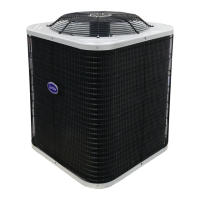Assuming that a system is pressurized with either all refrigerant or a mixture of nitrogen and refrigerant, leaks in the
system can be found with an electronic leak detector that is capable of detecting HFC refrigerant. If system has been
operating for some time, make first check for a leak visually. Since refrigerant carries a small quantity of oil, traces of
oil at any joint or connection is an indication that refrigerant is leaking at that point. A simple and inexpensive method
of testing for leaks is to use soap bubbles. Any solution of water and soap may be used. Soap solution is applied to
all joints and connections in system. A small pinhole leak is located by tracing bubbles in soap solution around leak.
If the leak is very small, several minutes may pass before a bubble will form.
R-410A Refrigerant Charging — Refer to unit information plate for superheat charging procedure. R-410A
refrigerant cylinders contain a dip tube which allows liquid refrigerant to flow from cylinder in upright
position. Charge R-410A units with cylinder in upright position and a commercial type metering device in the
manifold hose. Charge refrigerant into suction-line. For all approved combinations, system must be charged correctly
for normal system operation and reliable operation of components. If system has lost all charge, weigh in charge
using dial-a-charge designed for R-410A refrigerant or digital scale. System charge should be fine-tuned by using
superheat method.
CHECK CHARGE
Factory charge amount is shown on unit rating plate.
Cooling Only Procedure
NOTE: If superheat or subcooling charging conditions are not favorable, charge must be weighed in accordance with
unit rating plate ±0.6 oz/ft of 3/8-in. (56g/m of 9.5 mm) liquid line above or below 25 ft (7.6 m) respectively.
EXAMPLE:
Charging Formula:
[(Lineset oz/ft x total length) – (factory charge for lineset)] = charge adjustment
Example 1: System has 25ft of line set using existing 1/4“liquid line. What charge adjustment is required?
Formula: (.27 oz/ft x 25ft) – (13.5 oz) = -6.75 oz; (8.0 g/m x 7.6 m) – (382.7 g) = -321.9 g
Net result is to remove 6.75 oz of refrigerant from the system
Example 2: System has 45 ft of existing 5/16” liquid line. What is the charge adjustment?
Formula: (.40 oz/ft. x 45ft) – (13.5 oz.) = 9 oz; (11.8 g/m x 13.7m) – (382.7 g) = -221.0 g
Net result is to add 4.5 oz of refrigerant to the system
The following procedure is valid when indoor airflow is within ±21 percent of its rated CFM:
1. Operate unit a minimum of 10 minutes before checking charge.
2. Measure suction pressure by attaching an accurate gage to suction valve service port.
3. Measure suction temperature by attaching an accurate thermistor type or electronic thermometer to suction line
near service valve.
4. Measure outdoor air dry bulb temperature with thermometer.
5. Measure indoor air (entering indoor coil) wet bulb temperature with a sling psychrometer.
6. Refer to “Super Heat Charging Table”. Find outdoor temperature and evaporator entering air web bulb
temperature. At this intersection, note superheat.
7. Refer to “Required Suction Tube Temperature”. Find superheat temperature and suction pressure. At this
intersection note suction line temperature.
8. If a unit has a higher suction line temperature than charted temperature, add refrigerant until charted temperature
is reached.
9. If unit has a lower suction line temperature than charted temperature, reclaim refrigerant until charted temperature
is reached.
10. When adding refrigerant, charge in liquid form into suction service port using a flow--restricting device.
11. If outdoor air temperature or pressure at suction valve changes, charge to new suction line temperature indicated
on chart.
NOTE: If line length is beyond 80 ft (24.38 m) or greater than 20 ft (6.10 m) vertical separation, See Long Line
Guideline for special charging requirements.
R410a refrigerant must be added to a system as a liquid since it is a blend. Adding liquid into suction service
port using a flow metering device for throttling it in slowly to avoid slugging the compressor or diluting and
washing out the compressor oil.

